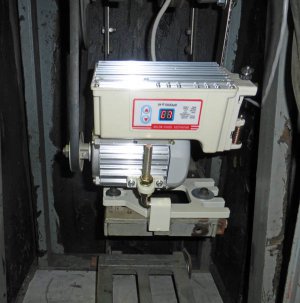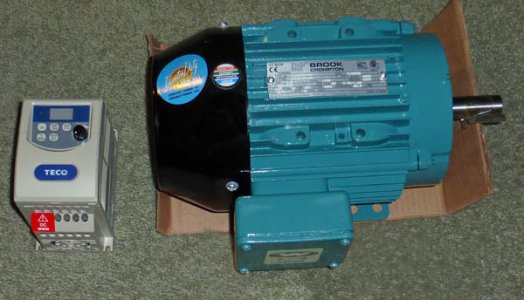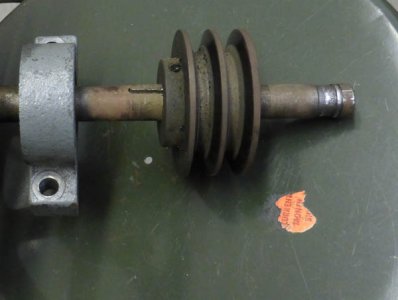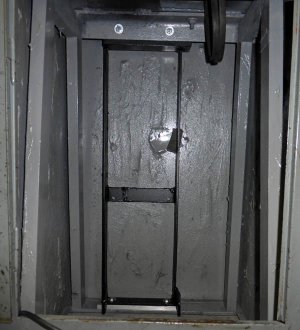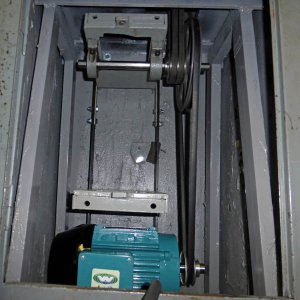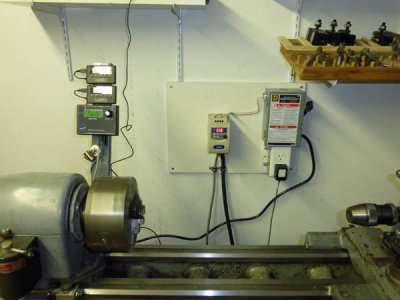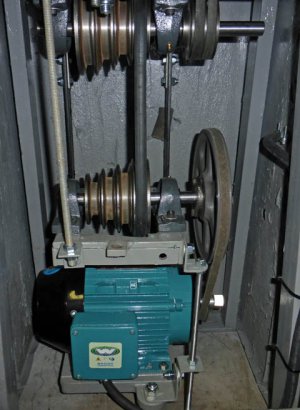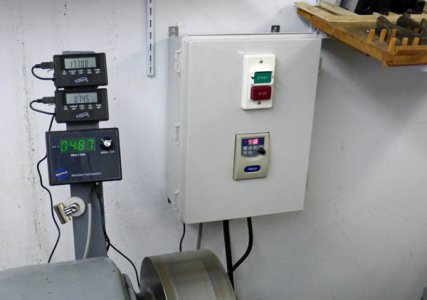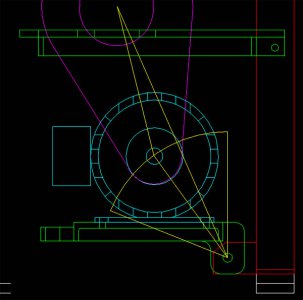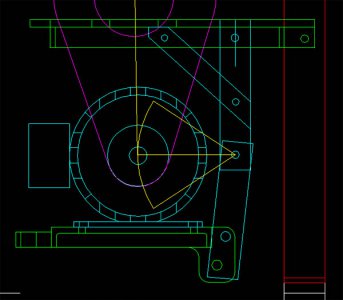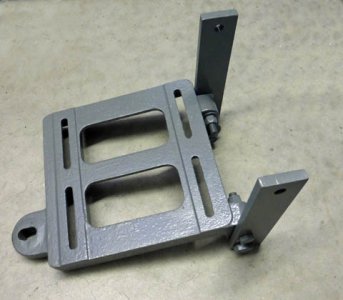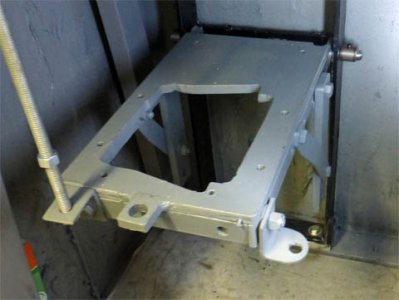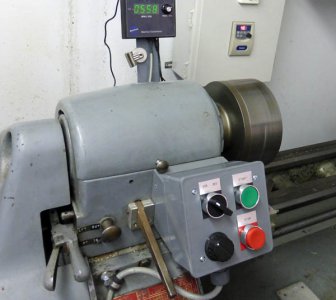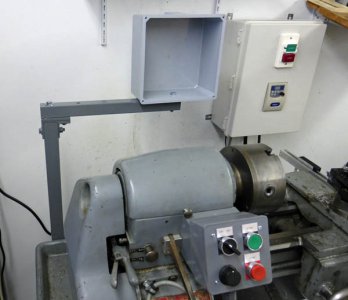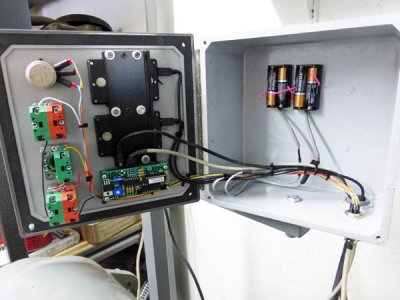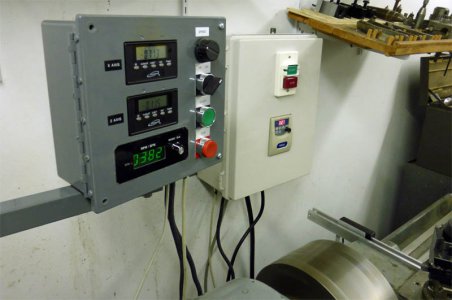Hi,
I thought I would start a thread on some upgrades I have done and am doing to my 11 inch Logan 957 lathe. I am not doing a restoration it as it is in generally good mechanical condition (although my last cleaning did a real number on the lathe's paint. I need to address that soon!) I am trying to modernize it to allow me to get better accuracy and make it easier to use, and almost as important, check off an item on my bucket list.
My dad bought this lathe in 1965 when it was about 8 years old. Sadly he passed away about 3 years later and I inherited it.
This is the Logan 957 lathe I am making these upgrades to.
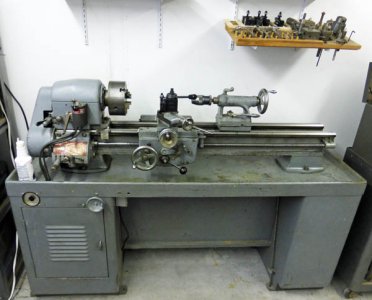
I added a quick change tool post and I am adding iGaging DROs, totally changing the mechanical drive between the motor and the spindle, adding a VFD and new motor, and adding a MachTach tachometer.
I decided to use iGaging DROs on the carriage and the cross slide, as I blew my budget adding a DroPros DRO to my mill recently. Davidh, on this forum, has a great price on both iGaging and Accu-Remote DRO scales.
To check things out, I mounted a 36 in. scale on the back of the bed using magnets retrieved from obsolete computer hard drives. I just snapped the magnets to the end brackets and placed it on the cast iron bed. It held remarkably well! I made a simple sheet aluminum bracket between an existing bolt on the carriage and the DRO head. I had a working Z axis DRO. It was very stable and accurate, and never slipped or moved on the magnets while I used it in this temporary condition.
The 36 inch scale fits the side of the bed perfectly. The magnets are holding it tight.
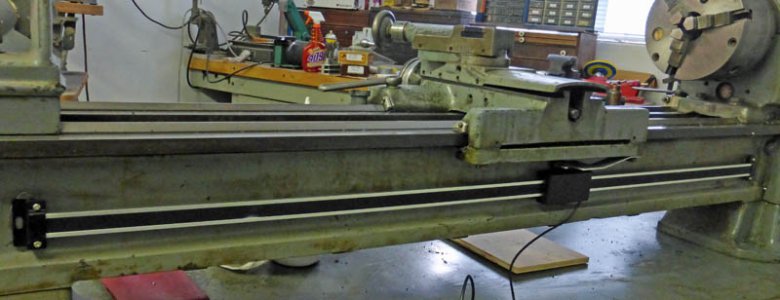
The cross slide was a totally different matter! The only place I saw I could readily mount the scale was on the spindle side with the read head between the rails, tied to the carriage. Again I tried magnets. The front mounted solidly on a machined side of the cross slide, but the rear had to stick to about a 1/4 inch wide section of the tail on the rough casting. Also the read head would crash into the chuck if I got careless (fortunately, I didn't). I found, using the magnets, they would build up a huge ball of chips when I machined steel or iron. I also noticed pock marks on the read head from hot chips hitting it. Good try, but no cigar!
The X scale just did not work on the left side of the cross slide. The gib screws would have
interfered on the right side.
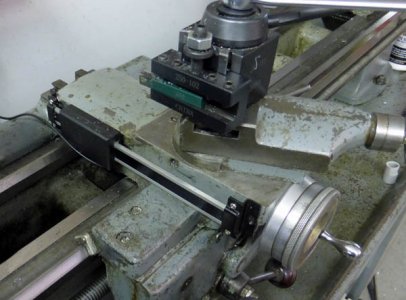
I temporarily mounted the displays on a piece of steel attached to the rear of the headstock,
letting the built in magnets hold them. I also mounted my MachTach here.
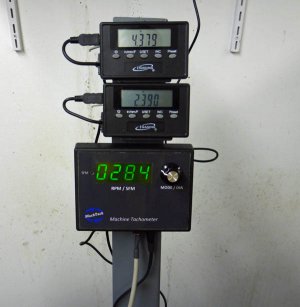
I then went ahead and permanently mounted the Z scale, removing the magnets and using 10-24 SHCS tapped into the bed casting.
After a lot of thought, I decided to mount the cross slide scale on the tailstock side to the rear of the carriage. By moving it to the rear, I avoided most of the gib screws and would keep things out of the way of most of the swarf and oil. I set up the cross slide in the mill and aligned it using a piece of drill rod clamped to the non-gib dovetail. I then took off about .050 to clean up the rough casting. I mounted an aluminum strip and mounted the scale to it. An aluminum bracket between the head and the carriage completed that mounting.
After machining a true mounting surface on the side of the cross slide, I fastened a bar of aluminum.
To this bar I mounted the X axis DRO scale and attached the read head to the carriage.
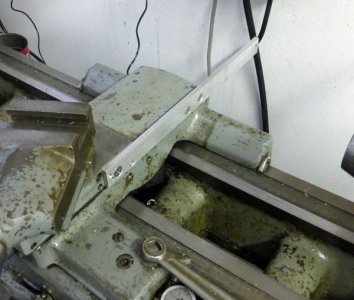
I had to provide a clearance hole for one gib screw and taper the end of the aluminum backing
plate slightly to allow a hex key access to lock the compound.
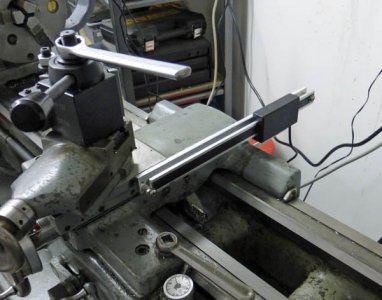
At the same time I was working on the DROs, I bought a MachTach and built it. I chose to use an IR reflective pickup located on the spindle at the left end of the headstock. I temporarily mounted the display unit under the DRO readouts.
I wrapped the spindle with electrical tape, then placed 6 reflective strips equally spaced around
it. The IR opto-sensor mounted to two existing tapped holes.
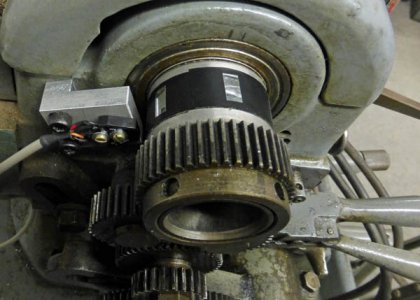
That completed the first phase up the upgrade.
Next I attacked the spindle drive. Shortly after inheriting the lathe, I changed the drive to a split hub pulley variable speed system. The pulley was one I found in the Grainger catalog. It has been working pretty well for about 45 years, but it is noisy and quite inefficient. It grabs the belts so hard, I have a hard time turning the chuck by hand.
I started hearing a high pitch squeal which I traced to the pulley end of the motor. I pulled the motor and opened it up and the shaft end bearing was very rough. I worked some 10 wt spindle oil past the shields and got it running fairly smoothly and put it all back together. I am going to need to do something with the motor pretty soon! I think this whole motor/drive assembly is history!
This is the variable speed pulley I installed somewhere around 1970 and it's been doing OK
but it is time for it to go! It's really ugly down here!
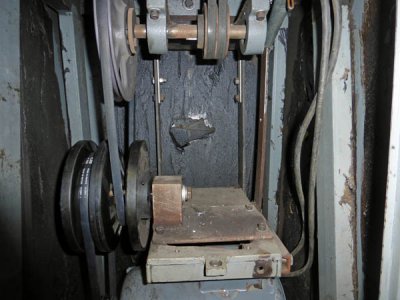
I'll continue this thread soon.
Dick








I thought I would start a thread on some upgrades I have done and am doing to my 11 inch Logan 957 lathe. I am not doing a restoration it as it is in generally good mechanical condition (although my last cleaning did a real number on the lathe's paint. I need to address that soon!) I am trying to modernize it to allow me to get better accuracy and make it easier to use, and almost as important, check off an item on my bucket list.
My dad bought this lathe in 1965 when it was about 8 years old. Sadly he passed away about 3 years later and I inherited it.
This is the Logan 957 lathe I am making these upgrades to.

I added a quick change tool post and I am adding iGaging DROs, totally changing the mechanical drive between the motor and the spindle, adding a VFD and new motor, and adding a MachTach tachometer.
I decided to use iGaging DROs on the carriage and the cross slide, as I blew my budget adding a DroPros DRO to my mill recently. Davidh, on this forum, has a great price on both iGaging and Accu-Remote DRO scales.
To check things out, I mounted a 36 in. scale on the back of the bed using magnets retrieved from obsolete computer hard drives. I just snapped the magnets to the end brackets and placed it on the cast iron bed. It held remarkably well! I made a simple sheet aluminum bracket between an existing bolt on the carriage and the DRO head. I had a working Z axis DRO. It was very stable and accurate, and never slipped or moved on the magnets while I used it in this temporary condition.
The 36 inch scale fits the side of the bed perfectly. The magnets are holding it tight.

The cross slide was a totally different matter! The only place I saw I could readily mount the scale was on the spindle side with the read head between the rails, tied to the carriage. Again I tried magnets. The front mounted solidly on a machined side of the cross slide, but the rear had to stick to about a 1/4 inch wide section of the tail on the rough casting. Also the read head would crash into the chuck if I got careless (fortunately, I didn't). I found, using the magnets, they would build up a huge ball of chips when I machined steel or iron. I also noticed pock marks on the read head from hot chips hitting it. Good try, but no cigar!
The X scale just did not work on the left side of the cross slide. The gib screws would have
interfered on the right side.

I temporarily mounted the displays on a piece of steel attached to the rear of the headstock,
letting the built in magnets hold them. I also mounted my MachTach here.

I then went ahead and permanently mounted the Z scale, removing the magnets and using 10-24 SHCS tapped into the bed casting.
After a lot of thought, I decided to mount the cross slide scale on the tailstock side to the rear of the carriage. By moving it to the rear, I avoided most of the gib screws and would keep things out of the way of most of the swarf and oil. I set up the cross slide in the mill and aligned it using a piece of drill rod clamped to the non-gib dovetail. I then took off about .050 to clean up the rough casting. I mounted an aluminum strip and mounted the scale to it. An aluminum bracket between the head and the carriage completed that mounting.
After machining a true mounting surface on the side of the cross slide, I fastened a bar of aluminum.
To this bar I mounted the X axis DRO scale and attached the read head to the carriage.

I had to provide a clearance hole for one gib screw and taper the end of the aluminum backing
plate slightly to allow a hex key access to lock the compound.

At the same time I was working on the DROs, I bought a MachTach and built it. I chose to use an IR reflective pickup located on the spindle at the left end of the headstock. I temporarily mounted the display unit under the DRO readouts.
I wrapped the spindle with electrical tape, then placed 6 reflective strips equally spaced around
it. The IR opto-sensor mounted to two existing tapped holes.

That completed the first phase up the upgrade.
Next I attacked the spindle drive. Shortly after inheriting the lathe, I changed the drive to a split hub pulley variable speed system. The pulley was one I found in the Grainger catalog. It has been working pretty well for about 45 years, but it is noisy and quite inefficient. It grabs the belts so hard, I have a hard time turning the chuck by hand.
I started hearing a high pitch squeal which I traced to the pulley end of the motor. I pulled the motor and opened it up and the shaft end bearing was very rough. I worked some 10 wt spindle oil past the shields and got it running fairly smoothly and put it all back together. I am going to need to do something with the motor pretty soon! I think this whole motor/drive assembly is history!
This is the variable speed pulley I installed somewhere around 1970 and it's been doing OK
but it is time for it to go! It's really ugly down here!

I'll continue this thread soon.
Dick










